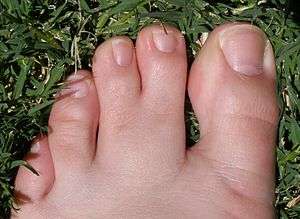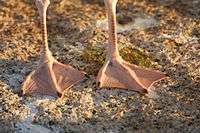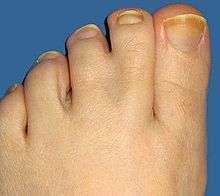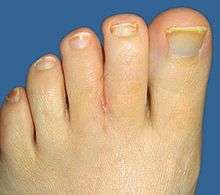Webbed toes
| Webbed toes | |
|---|---|
 | |
| Human foot with partial simple syndactyly. | |
| Classification and external resources | |
| Specialty | medical genetics |
| ICD-10 | Q70.3 |
| ICD-9-CM | 755.13 |
| MedlinePlus | 003289 |

Webbed toes is the common name for syndactyly affecting the feet. It is characterised by the fusion of two or more digits of the feet. This is normal in many birds, such as ducks; amphibians, such as frogs; and mammals, such as kangaroos. In humans it is considered unusual, occurring in approximately one in 2,000 to 2,500 live births.
There are various levels of webbing, from partial to complete. For example, the rare Hose's civet, a viverrid endemic to northern Borneo, has partially webbed feet. Most commonly the second and third toes are webbed or joined by skin and flexible tissue. This can reach either part way up or nearly all the way up the toe.
Diagnosis
This condition is normally discovered at birth. If other symptoms are present, a specific syndrome may be indicated. Diagnosis of a specific syndrome is based on family history, medical history, and a physical exam. Webbed toes are also known as "twin toes," "duck toes," "turkey toes" and "tiger toes."
Severity can vary. Most cases involve the second and third toes but any number of toes can be involved. In some cases the toes are joined part way while in some the webbing can extend right up to the nails. In some cases the entire toes, including the nails and bones, can be fused.
Cause
The exact cause of the condition is unknown. In some cases, close family members may share this condition. In other cases, no other related persons have this condition. The scientific name for the condition is syndactyly, although this term covers both webbed fingers and webbed toes. Syndactyly occurs when apoptosis or programmed cell death during gestation is absent or incomplete. Webbed toes occur most commonly in the following circumstances:
- Syndactyly or familial syndactyly
- Down syndrome
It is also associated with a number of rare conditions, notably:
- Aarskog–Scott syndrome
- Acrocallosal syndrome
- Apert's syndrome
- Bardet-Biedl syndrome
- Carpenter syndrome
- Cornelia de Lange syndrome
- Edwards syndrome
- Jackson–Weiss syndrome
- Fetal hydantoin syndrome
- Miller syndrome
- Pfeiffer syndrome
- Smith-Lemli-Opitz syndrome
- Timothy syndrome
- Ectodermal dysplasia
- Klippel-Feil syndrome
Consequences
Webbed toes in humans are a purely cosmetic condition. This condition does not impair the ability to perform any activity, including walking, running, or swimming. Depending on the severity and structure of the webbing, there can be some minor consequences.
People with more severe webbed toes may have a slight disadvantage for activities that benefit from prehensile toes, due to the toes being unable to move well. Although not scientifically proven, some believe that this condition can possibly allow for a slight advantage, specifically, in athletics. Considering your big toe is a main source for balance, having your second and third toe webbed could virtually be seen as having two big toes. Thus, allowing for better balance in athletics such as running or dance. However, the webbing may restrict the movement of the toes.
Psychological stress may arise from the fear of negative reactions to this condition from people who do not have webbed toes. In more severe cases the entire toes are held close together. Many people with webbed toes can physically feel the toes touching under the fused skin, which can cause psychological discomfort. This is due to the nerves of each toe fully developing and independent muscles working. In other cases where the toes are partially webbed, the webbing holds the separate tips of the toes against one another and prevents the muscles from spreading the toes apart, causing the toes and sometimes nails to press together.
However a disadvantage would be a difficulty in wearing flip-flops or other such footwear in warm countries. People with webbed toes may be unable to wear Toe socks or Vibram FiveFingers shoes. Difficulty navigating rough terrain barefoot, such as rocks at a beach is also common due to reduced mobility of the toes. In some cases the toes grow at different lengths causing the toes to buckle or bend and many people with severe webbed toes experience cramping in these toes due to the muscles and ligaments being strained.
Surgery


Webbed toes can be separated through surgery. Surgical separation of webbed toes is an example of body modification.
As with any form of surgery, there are risks of complications.
The end results depend on the extent of the webbing and underlying bone structure. There is usually some degree of scarring, and skin grafts may be required. In rare instances, nerve damage may lead to loss of feeling in the toes and a tingling sensation. There are also reports of partial web grow-back. The skin grafts needed to fill in the space between the toes can lead to additional scars in the places where the skin is removed.
Famous webbed feet
- Dan Aykroyd – Canada, actor[1]
- Tricia Helfer – Canada, actress[2]
- Jacqui Hurley – Ireland, sports broadcaster[3]
- Ashton Kutcher – United States, actor[4]
- Joseph Stalin – Soviet Union, General Secretary of the Communist Party of the Soviet Union[5]
- Danielle Panabaker – United States, actress[6]
See also
- Bird feet and legs - webbing and lobation
References
- ↑ Saner, Emine (2007-09-19). "Soul survivor". The Guardian. London. Retrieved 2008-01-01.
- ↑ "Tricia Trivia". Archived from the original on 2008-03-28. Retrieved 2008-03-22.
- ↑ Tubridy, Ryan (31 August 2011). "Here's what happened on today's show..." Tubridy. RTÉ 2fm. Archived from the original on 6 April 2012.
RTÉ's sports presenter Jacqui Hurley called in to tell Ryan that she also as webbed toes! Jacqui has two webbed toes on each foot. When Jacqui was younger she tried to cut them to make 'normal toes'! Now Jacqui has come to love her toes! Her Brother and Dad also have webbed feet.
- ↑ "Star Tracks (People magazine)". Retrieved 2008-03-27.
- ↑ ""Among the Dead", MississippiReview.com". Archived from the original on 2008-03-18. Retrieved 2008-03-27.
- ↑ "famous people webbed toes".